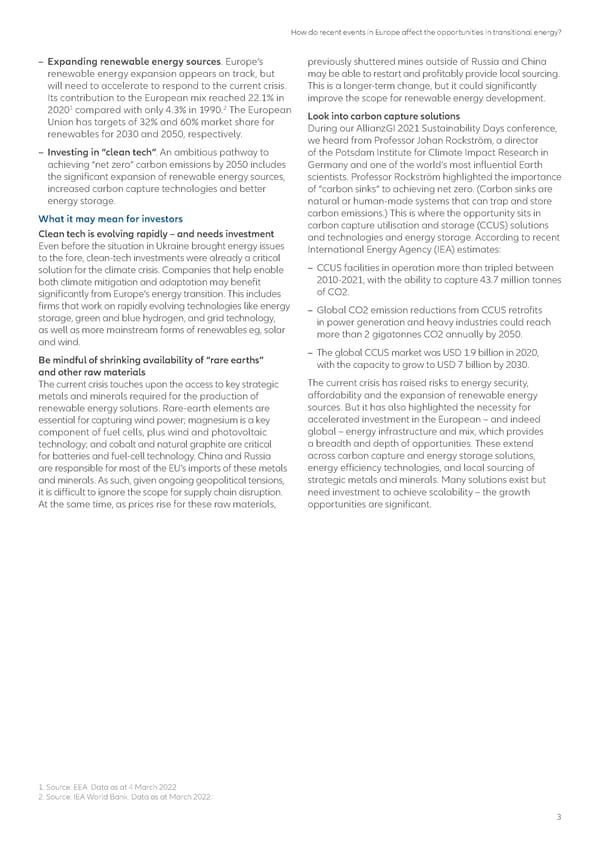How do recent events in Europe affect the opportunities in transitional energy? – Expanding renewable energy sources. Europe’s previously shuttered mines outside of Russia and China renewable energy expansion appears on track, but may be able to restart and profitably provide local sourcing. will need to accelerate to respond to the current crisis. This is a longer-term change, but it could significantly Its contribution to the European mix reached 22.1% in improve the scope for renewable energy development. 1 2 2020 compared with only 4.3% in 1990. The European Look into carbon capture solutions Union has targets of 32% and 60% market share for During our AllianzGI 2021 Sustainability Days conference, renewables for 2030 and 2050, respectively. we heard from Professor Johan Rockström, a director – Investing in “clean tech”. An ambitious pathway to of the Potsdam Institute for Climate Impact Research in achieving “net zero” carbon emissions by 2050 includes Germany and one of the world’s most influential Earth the significant expansion of renewable energy sources, scientists. Professor Rockström highlighted the importance increased carbon capture technologies and better of “carbon sinks” to achieving net zero. (Carbon sinks are energy storage. natural or human-made systems that can trap and store What it may mean for investors carbon emissions.) This is where the opportunity sits in Clean tech is evolving rapidly – and needs investment carbon capture utilisation and storage (CCUS) solutions Even before the situation in Ukraine brought energy issues and technologies and energy storage. According to recent to the fore, clean-tech investments were already a critical International Energy Agency (IEA) estimates: solution for the climate crisis. Companies that help enable – CCUS facilities in operation more than tripled between both climate mitigation and adaptation may benefit 2010-2021, with the ability to capture 43.7 million tonnes significantly from Europe’s energy transition. This includes of CO2. firms that work on rapidly evolving technologies like energy – Global CO2 emission reductions from CCUS retrofits storage, green and blue hydrogen, and grid technology, in power generation and heavy industries could reach as well as more mainstream forms of renewables eg, solar more than 2 gigatonnes CO2 annually by 2050. and wind. Be mindful of shrinking availability of “rare earths” – The global CCUS market was USD 1.9 billion in 2020, and other raw materials with the capacity to grow to USD 7 billion by 2030. The current crisis touches upon the access to key strategic The current crisis has raised risks to energy security, metals and minerals required for the production of affordability and the expansion of renewable energy renewable energy solutions. Rare-earth elements are sources. But it has also highlighted the necessity for essential for capturing wind power; magnesium is a key accelerated investment in the European – and indeed component of fuel cells, plus wind and photovoltaic global – energy infrastructure and mix, which provides technology; and cobalt and natural graphite are critical a breadth and depth of opportunities. These extend for batteries and fuel-cell technology. China and Russia across carbon capture and energy storage solutions, are responsible for most of the EU’s imports of these metals energy efficiency technologies, and local sourcing of and minerals. As such, given ongoing geopolitical tensions, strategic metals and minerals. Many solutions exist but it is difficult to ignore the scope for supply chain disruption. need investment to achieve scalability – the growth At the same time, as prices rise for these raw materials, opportunities are significant. 1. Source: EEA. Data as at 4 March 2022 2. Source: IEA World Bank. Data as at March 2022. 3
 How do recent events in Europe affect the opportunities in transitional energy? Page 2 Page 4
How do recent events in Europe affect the opportunities in transitional energy? Page 2 Page 4